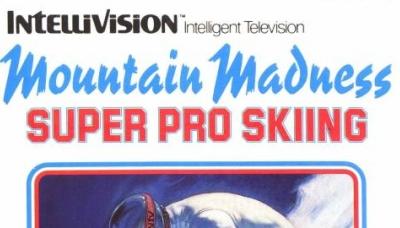Mountain Madness Super Pro Skiing (0)

Overview
Mountain Madness Super Pro Skiing was developed by for , and released in 1988 for the . While Mountain Madness is not officially a sequel, it serves as a spiritual successor to , and uses much of the same code.Much like in U.S. Ski Team Skiing, up to six players take turns skiing down a mountainside rife with trees and moguls attempting to earn the fastest time. Mountain Madness Super Pro Skiing adds more hazards, including ice and unpacked snow, and adds a selection of 32 preset mountainsides. The player also has the option of designing their own course, or skiing down a randomized slope.
There is no computer AI in Mountain Madness, so the game can only be played in a solo practice mode or in competition with friends.
Gameplay
Setup
Mountain Madness starts with selecting how many players will be playing, from one to six. The colors used for each skier are as follows:
- Player 1: Blue
The map preview screen - Player 2: Red
- Player 3: Tan
- Player 4: Dark Green
- Player 5: Green
- Player 6: Yellow
Once the number of players is chosen, the "flag style" is selected, from either downhill, slalom, or no flags. Slalom is the most difficult, with narrow flag gates, while downhill has wider and more forgiving flag gates. No flags is exactly how it sounds: no flag gates, so the race is straight to the bottom of the course.
Next, the course is selected. There are 32 preset courses in Mountain Madness, and a map showing their general path and conditions can be viewed before the selection is made. In addition, there is the option of a Helicopter course, which will take the player to a random course on a random mountain, or design their own course, which is discussed later.
Finally, the slope for the course is chosen, which determines the speed of the skier. The slope varies between one (slow) and fifteen (very fast). In a reality-breaking move, players can choose different slopes for the same mountain course. However, time will move at the same pace, so players choosing a faster slope will have a definite advantage, provided they can control their skier without problems.
Racing
Each player takes their turn alone on the mountain, situated up at a starting gate with the best times from each player to the left. Before taking off, players can opt to view the map of the course one final time.
The skier will encounter hazards such as trees, moguls, icy snow, and powder snow. Trees must be outright avoided, but moguls and powder can be jumped over safely. Icy snow does not need to be avoided, but will hamper the turning ability of the skier. Hitting any obstacles other than ice will cause the skier to crash, slowing them down tremendously and taking away all of their momentum. Hitting a flag is not as critical, but the impact will slow the skier down somewhat. Also, running into the crowd at the end of the track will trip up the skier.
Each skier receives three runs, with only their best run counting. The winner is the skier with the fastest time.
Course Designer
Beyond the 32 courses in the game, players can create their own tracks using pre-fabricated segments of track. There are 28 of these segments to choose from when creating a course, and at least three segments (or at most fifteen segments) must be placed before the course can be used. Once the track is finished, players choose their slope, and the game continues normally with the custom course.
Custom slopes cannot be saved, so players wishing to save their masterpiece would do well to write down all the segment numbers used for future reference.


